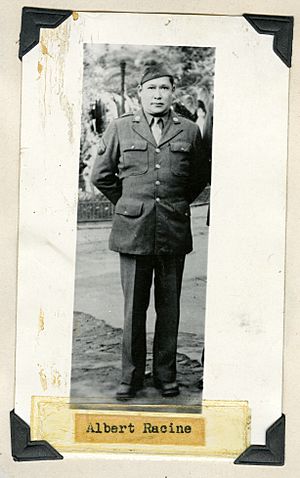Albert Racine facts for kids
Quick facts for kids
Albert Batiste Racine
|
|
|---|---|
| Apowmuckon | |

Albert Racine in uniform during WWII
|
|
| Born | April 19, 1907 Browning, Montana, U.S.
|
| Died | 1984 |
| Other names | Running Weasel |
| Known for | relief carving, sketching |
Albert Batiste Racine, also known by his Blackfoot names Apowmuckon or Running Weasel, was an amazing artist. He was born on April 19, 1907, in Browning, Montana, USA, and lived until 1984. Albert Racine was a member of the Blackfoot Confederacy, a group of Native American tribes.
He started his art career as a painter. By 1936, he became well-known for his detailed wood carvings. These carvings showed the daily life and culture of the Blackfeet Nation.
Contents
Albert Racine's Early Life and Art Training
Albert Racine grew up in Browning, Montana. He went to Browning Public Schools. Later, he attended the Haskell Indian Nations University in Lawrence, Kansas. This is a special university for Native American students.
Racine learned from many talented artists. He studied with German artist Winold Reiss at his summer art school. This school was located at Saint Mary Lake in Montana. He also learned sculpting from artists Adrien Voisin and John Louis Clarke. Other teachers included Edward Everett Hale Jr. and Carl Hertig Sr.
How Albert Racine Became a Wood Carver
Albert Racine first showed his artwork in 1927. He became a wood carver in 1938. That year, he created a special carving for the Browning Methodist Church. It was a wood carving of Leonardo da Vinci's "The Last Supper". This project helped him start his career in wood carving.
Albert Racine's Military Service
In 1942, Albert Racine joined the United States Army. He served during World War II. His time in the military took him to North Africa. Even while serving, he continued his art.
Napi: A Special Character
While in school, Racine became very interested in a Blackfoot folk hero named Napi. Napi is a trickster character in Blackfoot stories. Racine created his own unique drawing of Napi. He imagined Napi as a skinny figure with a potbelly, a big hat, and a mischievous smile.
During World War II, Racine sent sketches of Napi in a military uniform back home to Montana. Different versions of his Napi sketch were used on signs in Browning. Napi also appeared in Racine's carvings and other drawings.
Albert Racine's Art Gallery
For several years, Albert Racine ran his own art gallery. It was called the Blackfeet Indian and Western Art Gallery. It was located in Browning. In his gallery, he sold his own sculptures, carvings, and paintings. He also sold leatherwork and beadwork made by other local artists.
His artwork has also been shown at the Museum of the Plains Indian in Browning. This museum is run by the Indian Arts and Crafts Board.
Images for kids


